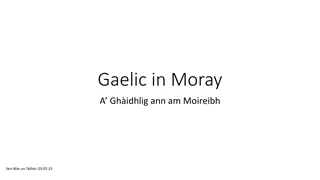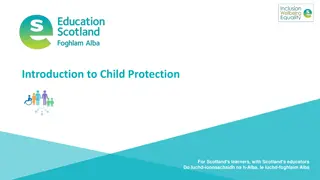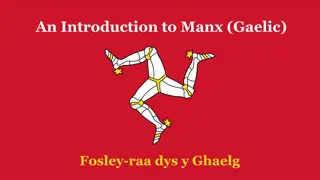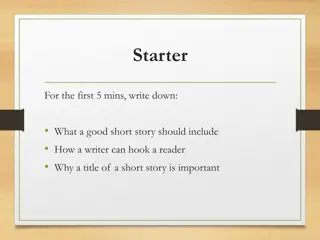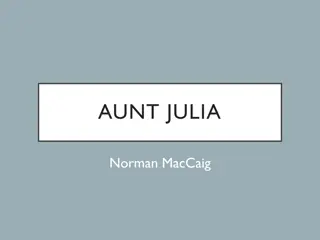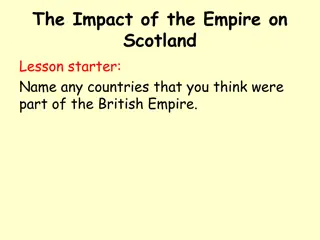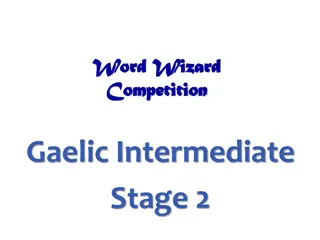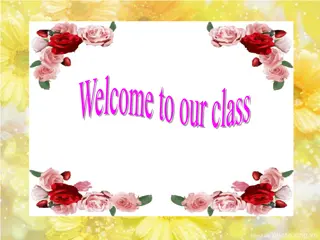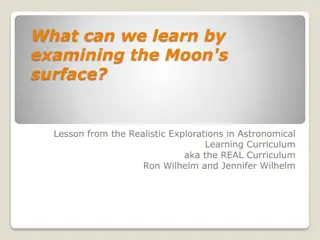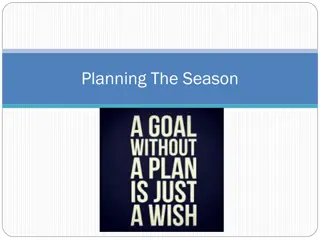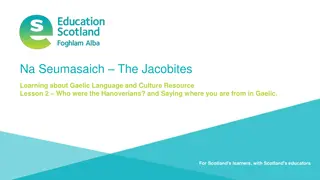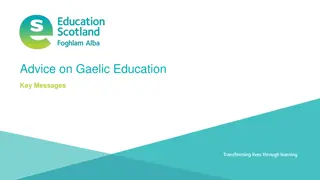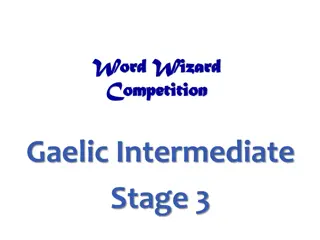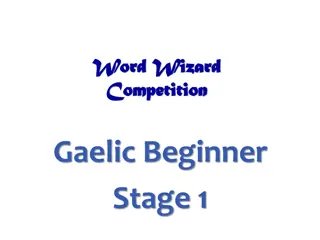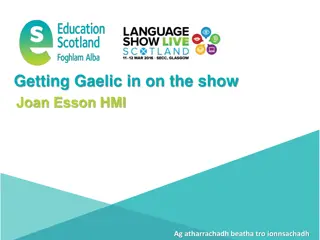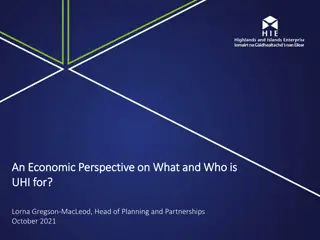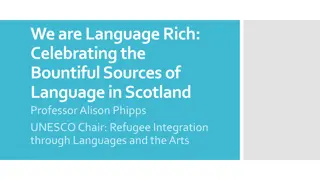Exploring Life in the Gaelic-Speaking Highlands of Scotland: A Journey Through History
Discover the rich Gaelic culture and history of the Highlands through lessons on language, clans, and daily life in 1745. Uncover the stories of Jacobite supporters, the importance of the Clan system, and the geographical divide between Gaelic and non-Gaelic speakers. Dive deep into the unique aspects of Highland life and explore the significance of everyday people in shaping history.
Download Presentation

Please find below an Image/Link to download the presentation.
The content on the website is provided AS IS for your information and personal use only. It may not be sold, licensed, or shared on other websites without obtaining consent from the author. Download presentation by click this link. If you encounter any issues during the download, it is possible that the publisher has removed the file from their server.
E N D
Presentation Transcript
Na Seumasaich The Jacobites Learning about Gaelic Language and Culture Resource Lesson 5 Life in the Highlands in 1745 The Clans. Saying how you are and discussing your family and Gaelic skills For Scotland's learners, with Scotland's educators
Na Seumasaich Lesson 5 In this Learning about Gaelic Language and Culture resource lesson we will learn: about the Gaelic culture of the Highlands of Scotland about a famous Jacobite poet, Alasdair mac Mhaighstir Alasdair to say that we have skills in Gaelic to ask someone if they have skills in Gaelic to say how we are in Gaelic to ask someone how they are in Gaelic to understand how to say this in contexts about the importance of music in Gaelic culture about the clan system in the Highlands of Scotland to create short texts about ourselves and others in Gaelic
Miri and Calum Ciamar a tha thu a Chaluim? Tha gu math tapadh leat. Ciamar a tha thu fh in? Chan eil gu dona. A bheil br ithrean no peathraichean agad? Tha. Tha br thair agam agus tha piuthar agam.
Im excited to hear what happens next! Well, history isn t always just about Kings and Queens and Princes and battles. It s about normal everyday people. I suppose you are correct,. I should learn about the men who fought for the Prince. Not just men! And not everyone in the Highlands supported the Jacobites. They had a life quite different from people today. I look forward to finding out more about all these people.
The Highlands of Scotland A Gh idhealtachd Although Gaelic was once spoken over most of what is now modern Scotland in the Middle Ages, by the middle of the 18th Century the Gaelic speaking areas were almost entirely on the North and West of what is called the Highland Boundary Line. It was calledA Gh idhealtachd the place where the Gaelic speakers live but because it was very mountainous, it was called in English. The Lowlands or A Ghalltachd the place where the non-Gaelic speakers live was either Scots or English speaking. At this point in history, both were quite equal in terms of population. Geography, language and Culture combined to create a divide between peoples. Jrockley Jrockley - Own work, based on Image:Scottish clan map blank.png Public Domain Image:Scottish clan map blank.png
The Highlands of Scotland A Gh idhealtachd 2 Life in the Highlands revolved around the Clan system and the Gaelic language. These two aspects of life meant that although there was often cattle raids and small battles, life was often peaceful and a rich culture flourished. Gaelic was part of a history and literature going back to the time of Christ. The Clan was headed by a Chief. He was seen as a father-like figure by those related to him, and those who weren t pledged allegiance to him for protection. The Lowlanders disliked the power of the clans in the North. They did not trust the Gaels, and tried to stereotype them as lazy, wild and untrustworthy. The Gaels called this M -r n M r nan Gall the Great Hatred of the Lowlanders. Over the years, the Lowland Scots had tried to make laws to weaken the Highlanders. Jrockley Jrockley - Own work, based on Image:Scottish clan map blank.png Public Domain Image:Scottish clan map blank.png
The Highlands of Scotland A Gh idhealtachd Questions Q1 - What is the line between the Highlands and the Lowlands called? Q2 - What languages did the Lowlanders speak? Q3 - What shows that the two areas were quite equal? Q4 - What member of the family did people see their chief as? Q5 - How did the Lowlanders feel about the Gaels or Highlanders? Jrockley Jrockley - Own work, based on Image:Scottish clan map blank.png Public Domain Image:Scottish clan map blank.png
How to talk about your Gaelic language skills A bheil G idhlig agaibh? To say you have Gaelic skills, you say Tha G idhlig agam. If you don t have any Gaelic you say Chan eil G idhlig agam. Depending on your level of skill you can use beagan a little or m ran a lot To ask someone where they are from you, you ask A bheil G idhlig agad? Or if they are older or there is more than one A bheil G idhlig agaibh? Tha G idhlig agam Tha beagan G idhlig agam Tha m ran G idhlig agam Chan eil G idhlig agam
So the Jacobites spoke Gaelic? Not all Jacobites were Gaelic speakers, or indeed Highlanders. But almost every single one from the Highlands would have been a Gaelic speaker. They probably didn t even speak much English. What about the Prince? I know he could speak French and Italian. The Prince never got fluent in Gaelic, but he did have a Gaelic teacher, he was called Alasdair mac Mhaighstir Alasdair, and he was from Moidart. He was a Macdonald. It would have been important to know how to speak to your soldiers.
Task one Asking and saying you have a little Gaelic Your teacher will ask you A bheil G idhlig agad? Reply with Tha beagan G idhlig agam. Don t worry, you now have enough to say you have a little Gaelic! Caleb, A bheil G idhlig agad? Tha! Tha beagan G idhlig agam
Clann-cinnidh The Clan The word Clan is a common word in English, and is used throughout the world for various groups with a tight bond, often through blood or family. It comes from the Gaelic word, Clann, which means children. Everyone in a clan believed they were descended from a common ancestor. Many of them would use the word Mac to show this. Mac means son. Women would used Nic, which is the short version of Nighean, meaning daughter or girl. However, most people did not use this surname in every day life. They would however recognise each other by referring to who their father was, or what his job was. This sometimes created new surnames as well. Like Alasdair mac Mhaighstir Alasdair. (Alexander son of Master Alexander, his father was a minister.)
Clann-cinnidh The Clan Questions Q1 What does clan mean in English? Q2 - What is the Gaelic for these words? Children Son Daughter Q3 - What was the job of Alasdair mac Mhaighstir Alasdair s father?
Ceann-cinnidh The Chief In a clan, everyone looked to the ceann-cinnidh or chief as their head and protector. Although they would not all be related to him, they would fight for him but also had his protection. This was called d thchas, a sort of shared heritage. The chief would have lots of people who worked for him. He would have a piper (p obaire), a poet (b rd/filidh) and a harper (cl rsair) as well as several swordsmen who protected him. These elite warriors were called fine . The chief s heir would be called Tanaistear and would usually be the oldest son. The Clan Chief also depended on Fir-taca, Tacksmen. These distant relations would collect rent as money, animals or grain as well as raise troops in times of war.
Ceann-cinnidh The Chief Questions Q1 - What was the role of the chief in the clan? Q2 - How does the passage explain d thchas? Q3 - Name some of the jobs of the people who worked for the chief in Gaelic and English Q4 - What job did the Fir-taca/Tacksmen have for the chief?
Tha mi sgth Songs are an important part of Gaelic culture. This is a very simple Gaelic song. It is also called Buain na rainich (cutting bracken). It is a very old song, and one story is that it is about a fairy who fell in love with a mortal woman who then was locked away. He is very tired, cutting bracken alone. You may want to learn the verses to this song as well, but the chorus goes like this. Sing along when the chorus comes along. Record your class singing it together. Tha mi sg th 's mi leam fh n, Buain na rainich, buain na rainich, Tha mi sg th 's mi leam fh n, Buain na rainich daonnan LearnGaelic - Beginners - Little by Little - Learn a Gaelic song - Tha mi sg th
Alasdair mac Mhaighstir Alasdair Who s this guy? C e? D an t-ainm a th air? Seo Alasdair Mac Mhaighstir Alasdair. He is a very famous Gaelic poet or b rd. He also taught Bonnie Prince Charlie Gaelic.
Tha mi a fuireach ann an th Tharracail Alasdair mac Mhaighstir Alasdair 2 Alasdair MacDh mhnaill, or Alexander Macdonald was born circa 1698 in D il Eileadh (Dalilea) in the area of th Tharracail (Acharacle). His father was the tacksman of Dalilea and Episcopal minister for Cille Ch mhghain (Kilchoan) in the neighbouring district of ird nam Murchan (Ardnamurchan). He was related to the chiefs of Clanranald (Macdonalds) Because his father was called Maighstir Alasdair, Alasdair was known by the name Alasdair mac Mhaighstir Alasdair in Gaelic. His father s education and important position in the community meant that Alasdair himself received a very good education and was able to speak several languages. He became a teacher himself, but his great love was writing poetry. He published the first two non-religious books in Gaelic. He is considered one of the most important Scottish poets, almost as important as Robert Burns! th Tharracail D il Eileadh ird nam Murchan Cille Ch mghain He was a Jacobite all his life. He may even have fought in the 1715 uprising as a teenager. It was no surprise then that this clever and passionate Jacobite would be chosen to teach the Prince himself. Creative Commons Attribution-ShareAlike 3.0 Unported CC BY-SA 3.0 Creative Commons Attribution-ShareAlike 3.0 Unported CC BY-SA 3.0
Tha mi a fuireach ann an th Tharracail Alasdair mac Mhaighstir Alasdair Questions Q1 Why would Alasdair have been born into a well-off family? Q2 What was the benefit to Alasdair of his father s position in the community? Q3 What was Alasdair s favourite thing to do? What shows that he was very good at it? th Tharracail D il Eileadh ird nam Murchan Q4 What shows that Alasdair was always a supporter of the Jacobites? Cille Ch mghain Q5 Why would Alasdair have been a good person to teach the Prince Gaelic in your opinion? Creative Commons Attribution-ShareAlike 3.0 Unported CC BY-SA 3.0 Creative Commons Attribution-ShareAlike 3.0 Unported CC BY-SA 3.0
How to talk about how you are in Gaelic Ciamar a tha sibh? To ask how someone is in Gaelic you say Ciamar a tha thu? Or if they are older or there is more than one Ciamar a tha sibh? Tha mi gu math, tapadh leibh Chan eil mi gu dona, tapadh leibh There are many different ways to respond to this question but some simple responses are Tha mi gu math I am well Chan eil mi gu dona I am not bad Tha mi sg th I am tired Chan eil mi gu math I am not well Tha mi sg th, tapadh leibh Chan eil mi gu math, obh obh.
Ciamar a tha thu an-diugh? How are you today? Chan eil mi gu math Tha mi gu math Chan eil mi gu dona Tha mi sg th Tapadh leat Tapadh leibh Thank you (singular) Oh dear! Thank you (polite/plural) Obh obh!
Task two Asking and saying how you are Your teacher will ask you Ciamar a tha thu an-diugh? Choose a response from the ones you have learned already. Make sure you say Tapadh leibh or Obh obh if you re not well! Caleb, Ciamar a tha thu an-diugh? Tha mi gu math, tapadh leibh
Hai. A bheil Gidhlig agad? Task three - talking Go around the class and follow this example. Greet each other with a simple Hai or Hal Tha. Tha beagan G idhlig agam. Ask each other your Gaelic skills using A bheil G idhlig agad? Ciamar a tha thu an-diugh? Then ask each other how you are with Ciamar a tha thu? remember to say Tapadh leat with your answer. Tha mi gu math, tapadh leat.
Task four - writing You are going to add to your two profiles one for yourself, and one for a Highlander boy or girl from the time of the Jacobites. Examples You S mise Kayden Reese-Jones Tha mi Alba. Tha mi aon deug. Tha mi a fuireach anns a Ghearasdan Tha beagan G idhlig agam Write a sentence in Gaelic stating your first name and surname. Write a sentence in Gaelic stating where you are from. Write a sentence in Gaelic stating your age. Write a sentence in Gaelic stating where you stay. Then do the same for your Highlander. Write a sentence that gives your Gaelic skills. Your Highlander has lots of Gaelic! Highlander S mise Iseabail Chamshron Tha mi Alba. Tha mi deich. Tha mi a fuireach ann an Loch Abar Tha m ran G idhlig agam
Task four extension Teaghlach - Family You can use the same structure you use for your Gaelic skills to talk about your family. athair - father m thair - mother Tha br thair agam I have a brother Tha d phiuthar agam I have two sisters Tha tr peathraichean agus tr br ithrean agam I have three sisters and three brothers You could return to your profile from task four and add in family members you have if you want. br thair brother br ithrean - brothers piuthar sister peathraichean - sisters seanmhairor granaidh - grandmother seanair - grandad
Task five (A) - Factfile Draw a poster showing the roles of different people in the clan Use images and short texts to explain who people are and what their job was. You may want to include the chief (ceann- cinnidh), heir (tanaistear), tacksman (fir- taca), and any others mentioned in this lesson.
Task five (B)) Family tree Research your family tree and draw a poster to display it Draw a family tree and try and label everyone in Gaelic (athair, piuthar etc). you may even want to give them their Gaelic names. Not all families are the same, you may want to use faclair.com to find the words you want to describe other members of your family or even pets!
Education Scotland Denholm House Almondvale Business Park Almondvale Way Livingston EH54 6GA T +44 (0)131 244 5000 E enquiries@educationscotland.gsi.gov.uk For Scotland's learners, with Scotland's educators




